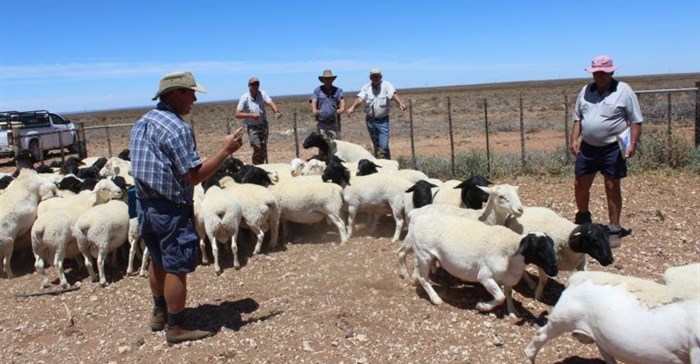
Top stories




EducationHow gender-inclusion in higher education can transform Africa’s future
Meekness Lunga-Ayidu 16 hours

LegalNigeria to implement new tax laws from January 1 despite calls for delay, Tinubu says
Camillus Eboh 2 days

However, SA Stud Book’s Elite small-stock breeder of the year for 2017, Jaco van Rensburg of Prieska, says that he measures the money-making traits of his ewes and lambs with great success and little effort, and succeeds in purposefully planning his livestock breeding programme.
Asked about his view on ‘production measurement’, his definition is short and sweet: “It is the measurement of the economically hidden traits of the animal.”
Stockfarm asked Dr Michael Bradfield, CEO of Breedplan SA, what is meant by the term ‘production measurement’. He agrees with Van Rensburg and explains that economically hidden traits include reproduction, growth, carcass and wool traits. “These are hereditary traits for which a stud breeder can select. Making genetic progress with these traits, requires sound production measurement.”
Dr Japie van der Westhuizen, general manager of SA Stud Book, extends the definition even further. He believes the overall purpose of production measurement is to increase the production efficiency of small stock, at herd and breed level.
“These measurements identify animals that produce best under these production conditions and will produce the best progeny in the next generation. This is then processed into a format that places the animals in order of their genetic merit for the economic important traits so as to enable breeders to make better selection choices,” he says.
Dr Van der Westhuizen says traits that make a difference to the profitability of breeding animals, are measured. Firstly one needs to measure the fertility and reproduction of female animals. In other words, if an animal regularly conceives, you measure the number of lambs she produces per lambing and whether she rears her lambs. This is followed by weighing the lambs pre-weaning and post-weaning. This will indicate two important traits, namely the growth capacity of lambs and the ewe’s ability to rear her lambs.
For some small-stock breeds only growth and reproduction need to be measured. “Some breeders also measure post-weaning growth – where veld ram tests are popular. The rams of different breeders are tested under the same veld conditions and their growth capacity is compared. After such a test, additional measurements can be done to determine certain carcass traits, such as body measurements, fat thickness and ciliary muscle depth. Some breeders even measure the individual feed intake of young rams.”
He says breeders of wool breeds will also measure traits that determine wool quality and the amount of wool growth or fleece weight. Dr Bradfield says other measurements include worm counts, birth weight, and 100-day, 200-day, one-year and mature weight.

Van Rensburg believes that modern farming methods actually forces one to measure, but in his experience, every farmer should determine for himself what he wants to measure and what he needs to measure to obtain the information – not only to improve his herd, but also to improve his bank account.
“This is one of the reasons why production measurement is intimidating to some small-stock producers. Looking at the information that has to be gathered, one starts wondering whether you will have time, given all the other responsibilities on the farm.”
Van Rensburg, who farms extensively with Boer goats, Dorpers and Van Rooy sheep, says he found that it is enough to measure growth and reproduction. “These two measurements provide you with a lot of information for your records. Small stock that show good growth and efficient reproduction, are usually very adaptable. These are the animals you want to sell to commercial farmers – adaptable animals that will increase the buyer’s profit.”
Van Rensburg says a stud breeder should not only look at the conformation and muscling of his animals and simply disregard the money-making traits.
His starting point is: “Form follows performance. I don’t care how beautiful an ewe looks. As long as she produces lambs and rears them by herself, she is allowed in my herd. The days of an ewe that does not conceive are numbered and she is quickly added to the slaughter list.
“One should learn to like the ewes that generate money. It does not help that you measure, select and breed for a certain conformation, but she does not generate a return. Rather look at the productive ewes which regularly lamb and rear their lambs.”

The databank
To people such as Van Rensburg, who farms productively and who believes in the value of production measurement, collecting data requires little effort. In this way, the animals within the herd can be measured, but when a breeder wants to know whether he or she is on par with the rest of the breeders at national level, it becomes a completely different story.
Dr Van der Westhuizen says service providers, such as SA Stud Book, help these breeders in building a data bank with information regarding their own herds, as well as animals they want to buy in future. “Breeders who record their small stock’s performance, provide Stud Book with birth notices containing birth weights to start the process. This indicates the reproduction efficiency of the ewe.”
Breedplan SA provides a similar service aimed at increasing national herd standards and helping producers to farm more successfully and profitably. Dr Bradfield summarises the benefits of production measurement in three points:

AgriOrbit is a product of Centurion-based agricultural magazine publisher Plaas Media. Plaas Media is an independent agricultural media house. It is the only South African agricultural media house to offer a true 360-degree media offering to role-players in agriculture. Its entire portfolio is based on sound content of a scientific and semi-scientific nature.
Go to: http://agriorbit.com/